Kostenloser Versand ab 35€ Bestellwert!
Im Juni 2022 haben wir die ersten 3D-Skizzen unserer vier neuen Plektrum-Modelle fertiggestellt. Die Picks waren jedoch nicht zu 100 % fertig.
Die Dicke, Größe und sogar die Namen der Plektren waren noch nicht definiert.
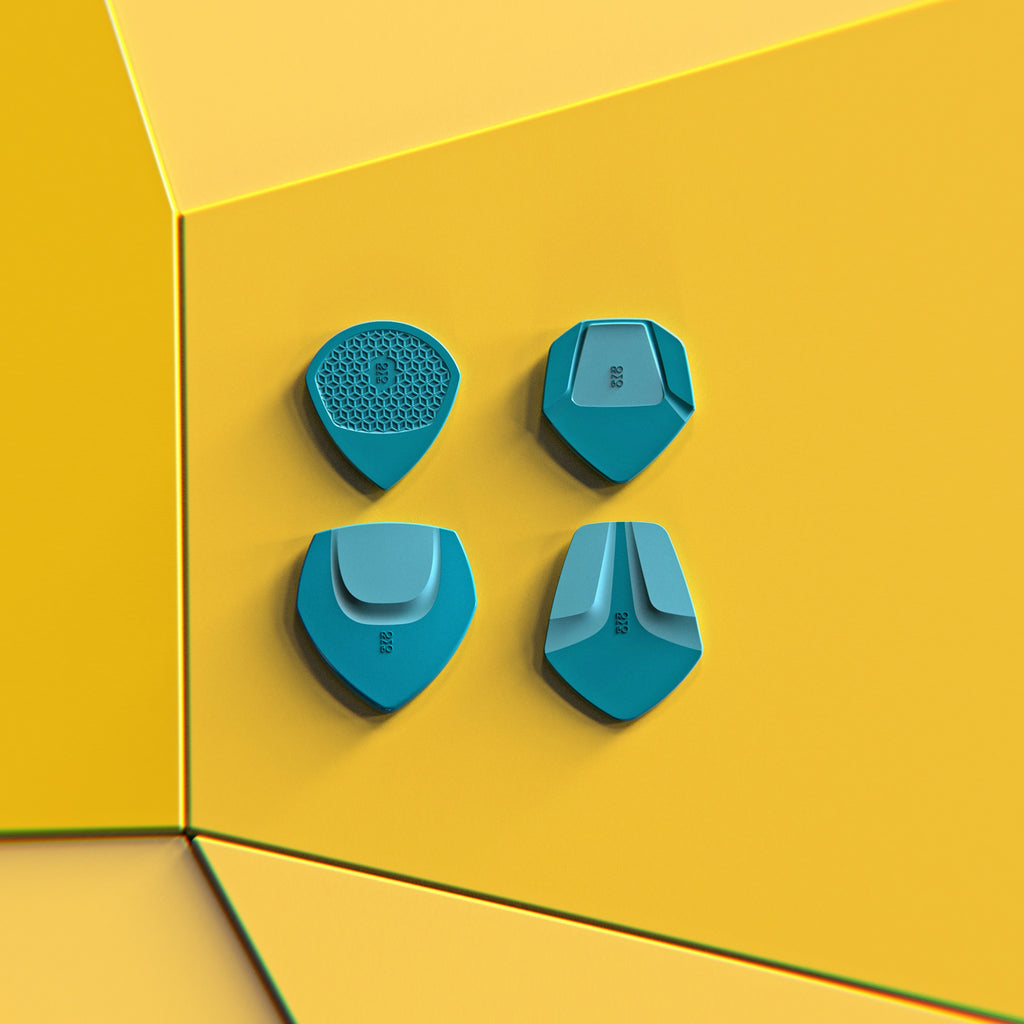
Wir haben uns für den Ansatz entschieden, so viele Gitarristen wie möglich einzubeziehen, um uns beim Co-Design unserer neuen Gitarren-Plektren zu helfen.
Das Ziel dieses Artikels ist es, die Ergebnisse der Umfrage zusammenzufassen, an der 2122 Gitarristen teilgenommen haben. Diese Leute haben das endgültige Design unserer Picks direkt beeinflusst.

Die Gitarren-Community hat Rombo seit seinem Start im Jahr 2019 stark unterstützt.
Wir wollten keine neuen Gitarrenpicks kreieren, ohne die Leute zu fragen, die von Anfang an dabei waren. Sie alle sind der Kern von Rombo, und Sie sollten entscheiden, welche Produkte wir entwickeln.
Der logischste Schritt war, eine große Umfrage zu erstellen, die es der Community ermöglicht, uns mitzuteilen, wie sie ihre Gitarrenplektren gern hätten. Wir glauben, dass dies der einzige Weg ist, ein Produkt zu entwickeln, das auf den Wünschen unserer Community basiert und uns ermöglicht, grundlegende Entscheidungen über die Ausrichtung unseres Unternehmens zu treffen.

Dies ist nur möglich, wenn man auf die Gedanken jedes Gitarristen hört.
2122 Gitarristen haben an der Umfrage teilgenommen und sich somit am Designprozess dieser neuen Gitarren-Plektren für 2023 beteiligt.
509 von ihnen hinterließen eine private Nachricht mit detaillierten Informationen.
Weiter unten gehen wir auf diese Nachrichten ein.



Es gibt einen klaren Gewinner. Gitarrenplektrum Nummer 2 ist der Favorit für die meisten Teilnehmer.
Könnte es an seiner Ähnlichkeit in Form und Größe mit dem legendären Jazz-III-Gitarrenpick liegen?
Überraschenderweise ist Nummer 4 das Gitarrenplektrum, das mich während des Prototypentests am meisten überrascht hat. Aber natürlich weiß man nie, bis man es probiert hat!

Name:
Durchschnittliche Dicke: 0,66 mm
Größe: Kleine Größe mit 89 % der Stimmen

Name:
Durchschnittliche Dicke: 0,953 mm
Größe: Mittlere Größe mit 77 % der Stimmen

Name:
Durchschnittliche Dicke: >2 mm
Größe: Große Größe mit 55 % der Stimmen

Name:
Durchschnittliche Dicke: 0,72 mm
Größe: Mittlere Größe mit 85 % der Stimmen

Insgesamt 509 Personen haben uns eine private Nachricht bezüglich Gitarrenpleks hinterlassen.
Wir haben sie alle sorgfältig gelesen und werden alle diese Informationen während der Entwicklung berücksichtigen.
Hier sind die 10 häufigsten Fragen, die wir wiederholt erhalten haben, und unsere Kommentare dazu:
● Werden die Plektren in verschiedenen Farben erhältlich sein?
Ja! Die Markteinführung umfasst alle regulären Rombo-Farben.
Weitere „Special Edition“-Farben sind in Vorbereitung.
● Werden sie die gleiche Griffstruktur haben?
Viele Leute haben uns E-Mails und Briefe bezüglich der Griffstruktur geschickt. Mit den Mikronoppen haben wir den Vorteil von mittelgriffigen Oberflächen, die viel Kontrolle hinzufügen.
Eine sehr kleine Anzahl von Menschen möchte jedoch, dass die Picks mehr Grip haben. Wir mussten hier eine Entscheidung treffen, und es war schwer. Wir werden die „Korndichte“ auf den strukturierten Bereichen leicht erhöhen, sodass mehr „Micro nodules“ pro Quadratmillimeter entstehen.
Auf diese Weise hoffen wir, den Bedürfnissen aller Gruppen gerecht zu werden.
● Das Material ist kühl, erzeugt aber warme und sanfte Töne. ich bevorzuge
helle Töne. Plant ihr ein neues Materialsortiment?
Wir haben unser Materialkomposition absichtlich geschaffen, um diese sanften Töne zu erreichen. Etwa 12 % der Benutzer gaben jedoch an, helle Töne zu bevorzugen.
Wir haben beschlossen, mit der Forschung an einem neuen Material zu beginnen, das als zusätzliches Sortiment auf den Markt gebracht wird, sobald wir die richtige Formel gefunden haben. Das voraussichtliche Datum für die Markteinführung des neuen Materials ist Anfang 2024.
● Warum erstellt ihr nicht für jedes Plektrum unterschiedliche Dicken?
der Modelle?
Wir möchten, dass jedes Plektrum einzigartig ist. Da jeder Mensch individuelle Vorlieben hat, glauben wir, dass jedes Plektrum sein eigenes Design haben sollte. In Zukunft hoffen wir, eine breitere Palette von Plektrumdesigns erstellen zu können, um jedes mögliche Bedürfnis abzudecken.
● Was ist mit Plektren für Bassisten?
Die meisten unserer Plektren sind mit Bass kompatibel, wie wir bei einigen Bassisten bestätigt haben, die sie regelmäßig verwenden, insbesondere Rombo Diamond und Rombo Origami. Das haben wir HIER erklärt.
● Ihr solltet Merch, T-Shirts und andere Dinge anbieten:
Vielleicht in der Zukunft. Jetzt wollen wir uns zu 100% auf die Entwicklung der Gitarrenpicks konzentrieren. Jede Minute, die wir für das Design eines T-Shirts aufwenden, wird von der Qualität der Picks abgezogen! ;)
● Werdet ihr die EcoBlack-Reihe in anderen Farben anbieten?
Das EcoBlack-Material kann derzeit nur einfarbig produziert werden.
Durch den Recyclingprozess entsteht eine sehr dunkle Pigmentierung. Die Industrie arbeitet hart daran, einen Weg zu finden, neue Recyclingverfahren zu schaffen. Wir hoffen, dass wir in Zukunft alle unsere Plektren aus recyceltem Material herstellen werden.
● Warum erstellet ihr keine Boutique-Picks?
Gegenfrage: Was ist ein Boutique-Plektrum?
Ein Boutique-Plektrum ist ein einzigartiges Kunstwerk in Form eines Plektrums, das ihr zum Gitarrenspielen verwenden könnt. Normalerweise sind diese Plektren handgefertigt und aus exotischen Materialien. Sie enthalten einige künstlerische Elemente wie Ornamentgeometrien und sind in der Regel einzigartige Sondereditionsstücke mit erhöhten Startpreisen.
Unser Ansatz ist ein anderer. Wir kreieren Boutique-ähnliche Gitarren-Pick-Designs zu sehr erschwinglichen Preisen. Andernfalls wären nur ein paar Rombo-Designs für die einflussreichsten Pick-Sammler verfügbar.
Wir glauben, dass wir auf diese Weise eine Nische zwischen Massenproduktions-Picks und einzelnen Sondereditionen gefunden haben. Mit diesem Ansatz bringen wir das Boutique-Feeling zu einer größeren Anzahl von Menschen und stärken die Plektrum-Community und das Bewusstsein für dieses kleine, aber wichtige Accessoire.
● Einige Plektren, die ich 2019 bestellt habe, hatten Grate. Dies ist kein Problem für
spielen, aber es sieht nicht cool aus.
Wir haben gute Nachrichten für Sie. 2021 haben wir eine neue Methode entwickelt, um die Grate manuell von den Plektren zu entfernen. Das bedeutet, dass alle Rombo-Picks manuell überarbeitet und bearbeitet werden, um alle visuellen Aspekte zu entfernen, die nicht zum ursprünglichen Design gehören (wie kleine Grate an der Umrandung).
Dies hat uns zusätzliche Zeit gekostet, aber als Premium-Marke müssen wir unsere Qualitätsstandards ständig verbessern, um sicherzustellen, dass eure Plektren so gut sind, wie ihr es erwartet!
● Warum nochmal Kickstarter?
Siehe unten :)
Die neuen Gitarrenpicks kommen im Frühjahr 2023 auf den Markt.
Wenn ihr eine E-Mail erhalten möchtet, sobald die Picks verfügbar sind, abonniert unseren Newsletter (siehe Fußzeile).
Dies ist der Zeitplan, den wir für dieses Projekt erstellt haben:

Kickstarter-Kampagnen lassen Träume und Ideen Wirklichkeit werden. Rombo ist immer noch ein kleines Start-up, das von zwei Personen geführt wird und nur begrenzten Zugang zu Ressourcen hat. Über Kickstarter binden wir die Community der Gitarristen ein und zeigen unsere Gitarrenplektren vor dem Start.
Dieser Prozess bringt uns in Kontakt mit den echten Gitarristen. Es zwingt uns, flexibel zu bleiben, Änderungen zu akzeptieren, und es fordert uns heraus, neue Designs zu entwickeln, um die Erwartungen unseres Publikums zu erfüllen.
Wir lieben offene und kritische Kritik, und dies ist der beste Ort dafür, wo alle Kommentare und Gedanken sichtbar sind. Indem wir Ihre Erfahrungen teilen, können wir auf eure Bedürfnisse und Wünsche eingehen und Gitarrenplektren entwickeln, die einen Unterschied machen.
Medium guitar picks are the most popular choice amongst guitarists and they offer the best of both worlds, right? Well, it is not that easy.

In our last article, “thin vs thick guitar picks”, we discussed both guitar pick thickness ranges in depth. Medium guitar picks deserve a separate analysis.
Guitar pick thickness is usually measured in millimeters and this is an attribute that can change various aspects of a pick like flexibility, tone, volume, pick noise, durability, control over single notes, and more.

The thickness of a guitar pick is for this reason considered one of the 4 fundamental attributes of a guitar pick, along with guitar pick material, shape, and size.
Medium guitar picks range in thicknesses from 0.55 and 1 mm.
The following is what a survey performed in March 2021 has shown. Thousands of guitarists were asked to define the following pick thicknesses:
With both limits established, we obtain the thickness definition of medium guitar picks.

The maximum thickness of a thin guitar pick was defined as about 0.55 mm by 2.292 guitarists.
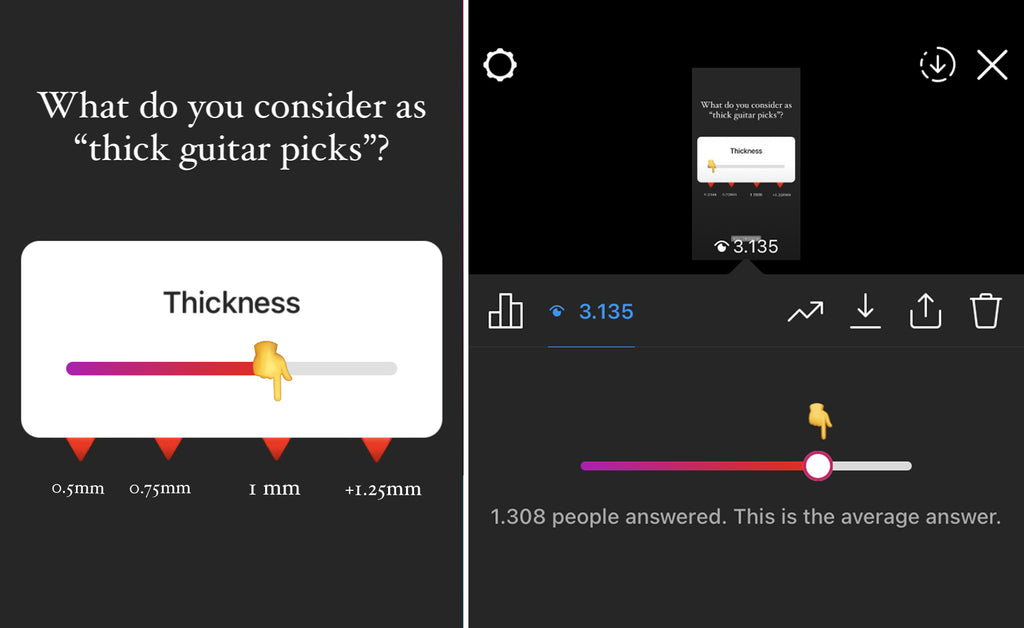
The minimum thickness of a thick guitar pick was defined as 1 mm by 1.308 guitarists.
Medium guitar picks are guitar picks with a thickness between 0.55 and 1 mm. These guitar picks are very popular because of their versatility; in some areas, they offer the advantages of both thin and thick guitar picks.

Medium gauge picks have the broadest flexibility range. In this pick thickness interval, the material will play the most important role when it comes to defining the flexibility of a pick.
In other words, thick guitar picks are always stiff and rigid. With thicknesses over 1 mm, even the most flexible pick materials are stiff, and therefore the material has less influence on the flexibility of the pick. This relation creates a broad flexibility range amongst medium guitar picks, which can be very flexible or very stiff, depending on the material used.

The same effect can be applied to tone, durability, and pick noise.
Typically, medium guitar picks are used by lead guitarists who also implement rhythm guitar techniques and look not only for an all-round compromise between single-note melodic phrases and strumming, but also potentially developing a more versatile guitar career that integrates different techniques and mixes both worlds together.
|
|
Thin guitar picks (under 0.55 mm) |
Medium guitar picks (0.55 - 1 mm) |
Thick guitar picks (over 1 mm) |
|
Flexibility |
Flexible/very flexible |
Medium flexibility or stiff, depending on the material. |
Rigid/very rigid |
|
Tone |
Lighter tones, less bass |
Warm tones for softer materials. Brighter tones for harder materials. |
Warm/dark tones and mellow tones |
|
Volume |
Maximum volume is limited. Lower dynamic range. |
Can provide high volume with the usage of hard materials. |
Provide high volume. Broader dynamic range. |
|
Guitar pick noise |
Noticeable pick noise |
Reduced pick noise when the pick has a variable thickness. |
Reduced pick noise |
|
Durability |
Less durable |
Depending on the material. |
More durable |
|
Control |
Less control for single notes |
Very versatile. Control of single notes is possible if the player is experienced with this type of pick. |
High control of single notes |
|
Popular techniques |
Rhythm guitar, strumming, tremolo picking, ... |
Very versatile. A combination of both thin and thick guitar picks is possible if the player is experienced with this type of pick. |
Lead guitar, shredding, sweep picking, ... |
|
Common type of players |
Beginners, acoustic guitar players |
Most popular thickness. Medium thickness is used by beginners, intermediate and advanced guitarists. |
Intermediate and advanced guitarists |
This makes medium gauge guitar picks the most difficult picks to estimate without having tested them, and it is one of the reasons why we created the “guitar pick parameters” included in every product page, like in Rombo Origami.

For most beginner guitar players, medium gauge guitar picks are the best option. You are in a process in which experimenting with sounds and learning new techniques will shape your profile as a guitarist in the future.
You might change your music taste during this process or even change your guitar type. You must stay flexible and versatile to allow your skills to develop in all directions and be a more rounded guitarist.
For this, a medium guitar pick is perfect, since you will be able to try different techniques with a pick that works very well in many different areas. After you have decided the direction of your development as a guitarist, increasing or decreasing the gauge won’t be that difficult.
Therefore, this is statistically the best option to start with if you want to try different guitar learning paths.

However, there are some exceptions: Some beginner guitarists know exactly what kind of player they want to be. They know from the very beginning if their dream is to become a very technical metal player, if they prefer being an expert acoustic guitar rhythm player, or if they will focus on songwriting and not on their guitar skills.
These examples are very rare, but they exist. In this case, you might want to consider starting with a guitar pick that has been designed for the type of skills you want to improve.
If you are a beginner, this might be interesting for you: Guitar pick for beginners
Rombo Origami guitar pick - 0.75 mm
Flexible but still rigid enough for note control. Right amount of flexibility for a snappy fluid attack that's bright and crisp. The concave surface on the hold area ensures ergonomic and comfortable hold.

Rombo Prisma guitar pick - 0.8 mm (available in September 2021)
A classic shape enhanced by modern surface technology. The geometry on the main body has different height levels for the most comfortable hold and grip.

Rombo Crisp guitar pick - 1 mm (available in September 2021)
Medium thickness combined with geometric concave design surfaces. The result? Unexpected flexibility with great bass tones. Its medium-sharp tip provides extra warm tones.

Each pick has a specific purpose, and you choose the pick based on the sound you want to achieve as well as other personal preferences like comfort and grip.
Medium picks are not just the picks in the middle of thick and thin guitar picks. They are a perfect approach for those guitarists looking to develop versatility and flexibility in their learning path.
Due to the high influence the material has on these picks, they are the most difficult picks to estimate before testing them, and every medium guitar pick is unique. Despite this, they are the best choice for most beginner guitarists.
However, if you have a very clear idea of the skills you want to develop in the future, you might be looking for either thin or thick guitar picks, which we discussed here.
Plektrumgeräusche lassen sich nicht ganz vermeiden. Insbesondere bei der Aufnahme von Akustikgitarren neigen Plektren dazu, viele Klick- und Klackgeräusche und Geräusche zu erzeugen, die dein Spielerlebnis sowie das deiner Zuhörer ruinieren kann.
Beim Gitarre lernen, wirst du einen Punkt erreichen, an dem du dich auf die Übertragung von Emotionen, das wirkungsvolle Spielen und eine bessere dynamische Kontrolle konzentrieren möchtest.
Um Gitarrentechniken zu meistern, musst du jeden Ton, der von der Gitarre erzeugt wird, vollständig kontrollieren: beabsichtigte und unbeabsichtigte.

Ich persönlich denke, dass Plektrumgeräusche ein Teil des Gitarrenspiels sind, und ich genieße sogar einige Vintage-Aufnahmen, bei denen das Plektrumgeräusch fast absichtlich vorhanden zu sein scheint. In den meisten Fällen möchtest du es jedoch beseitigen.
Wir haben alle Tipps und Tricks zusammengefasst, von denen wir glauben, dass sie dir helfen können, die Geräusche beim Spielen mit einem Plektrum zu reduzieren.
Gitarrenpicks erzeugen beim Zupfen/Anschlagen der Saiten Geräusche. Wenn du dein Plektrum lockerer hältst, hilft das sehr, da deine Finger einen Teil der Energie absorbieren, wenn das Plektrum auf die Saiten trifft.
Wir haben einen Artikel mit dem Titel „Wie man ein Gitarrenplektrum hält“ veröffentlicht, der alles enthält, was du wissen musst, um diesen Trick zu meistern.

Beim Aufnehmen kann es hilfreich sein, dein Instrument im Verhältnis zu den anderen etwas lauter zu machen. Dies ist eine in Studios übliche Methode, die den Gitarristen hilft, sich zu entspannen.
Egal, ob du eine Studio-Session, einen Jam mit deinen Freunden oder einige Solo-Relax-Sessions zu Hause planen, ein bewusstes Aufwärmen vor dem Gitarre spielen ist Pflichtprogramm.

Der Winkel des Plektrums im Verhältnis zu den Saiten ist das am meisten diskutierte Element, wenn es um Plektrumgeräusche geht.
Grundsätzlich gilt: Je weniger Plektrum mit den Gitarrensaiten in Kontakt kommt, desto weniger Lärm erzeugt es. Deshalb winkle das Plektrum leicht zu den Saiten an.
Probiere verschiedene Winkel beim Anschlagen und Zupfen aus. Dies erfordert eine bewusste Anpassung deinerseits, aber sobald du es gemeistert hast, kannst du den Anschlag des Picks leichter variieren.
Abhängig vom verwendeten Plektrum, dem Musikstil und den Gitarrentechniken, die du verwendest, und deinem Können, benötigst du einen anderen Anschlagwinkel. Konzentriere dich also 30 Minuten darauf, den besten für dich zu finden, und gewöhne dich daran, diesen zu spielen.
Manchmal spielt man und der Flow setzt ein, man verlässt gedanklich den Raum und betritt „die Zone“, diesen schönen Ort, an dem man besser klingt als sonst.
Wir gehen so sehr in die Musik hinein, dass wir natürlich härter zuschlagen.

Übermäßige Anschlagkraft ist eine der häufigsten Ursachen für Plektrumgeräusche. Darüber hinaus kann es das Sustain abwürgen und dazu führen, dass die von dir gespielten Noten auf viel weniger natürliche Weise ausklingen.
Das Material der Gitarren-Plektren beeinflusst nicht nur den Ton, sondern auch das Geräusch, das das Plektrum erzeugt.
Nylon gilt als eine der am wenigsten lauten Formeln, wenn es um industrielle Materialien geht, die für Gitarrenpicks verwendet werden.
Dies liegt an der Zähigkeit dieser Mischung, die dank ihrer mechanischen Eigenschaften starke Stöße effizient absorbieren kann.

Bei Rombo verwenden wir eine modifizierte Version von Nylon, die für zusätzliche Haltbarkeit sorgt und die Lebensdauer der Plektren verlängert. Dies war notwendig, da Gitarrenpicks aus Nylon sehr schnell verschleißen. Hier erfährst du mehr über die Materialien.
Wenn du dir nicht sicher bist, ob du das richtige Plektrum verwenden, ist ein Variety-Paket eine gute Option, das Gitarrenpicks mit unterschiedlichen Attributen enthält. Dies ist eine gute Möglichkeit, mehrere Picks zu testen und deine Entwicklung zu verfolgen, während du beginnst, deine Fähigkeiten für jedes einzelne Plektrum zu verbessern.
Als Faustregel kann man sagen, dass schwerere Plektren weniger laut sind, was irgendwie widersprüchlich klingt. Aber warum ist das so?

Die Verwendung sehr dünner Plektren in Kombination mit schnellem Spiel, wie Strumming, führt dazu, dass sich die Plektren verbiegen, wenn sie die Gitarrensaiten verlassen, wodurch eine Art Klickgeräusch entsteht. Dies geschieht besonders beim Spielen von Akustikgitarren, da der Korpus der Gitarre als Verstärker für diesen Klang fungiert.
Schwerere Plektren lassen jede Saite ihren eigenen Ton ohne viele Begleitgeräusche erzeugen.

Die variable Dicke, die in allen unseren Gitarrenplektren enthalten ist, verbessert nicht nur die Kontrolle, sondern reduziert auch das Rauschen. Der Körper des Plektrums ist dicker und steifer, während die Spitze dünner und flexibler ist. Mit diesem Merkmal wird die Gesamtflexibilität der Spitze verringert, während ihre ursprüngliche Dicke und ihr ursprüngliches Material beibehalten werden. Das bedeutet mehr Kontrolle und weniger Lärm.
Dicke vs. dünne Plektren. In diesem Artikel besprechen wir alle Aspekte, die einen Unterschied machen.
Plektren mit einer abgeschrägten Kante gleiten besser und verursachen weniger Geräusche. In Kombination mit dem bereits erwähnten Anschlagwinkel können sie dir dabei helfen, das Plektrumgeräusch stark zu reduzieren.
Auch die Form und Größe des Plektrums sind wichtig, aber das ist eher eine Frage der Präferenz.

Wir haben häufig darüber gesprochen, welchen Einfluss eine polierte Spitze auf den Ton und die Haltbarkeit eines Gitarrenpickels hat.
Eine polierte Spitze gleitet auch ganz leicht über den Rand der Gitarrensaite. Auf der anderen Seite erzeugen Gitarrenplektren mit einer raueren Textur an der Spitze eine stärkere Höhenwiedergabe, selbst wenn sie am Rand gespielt werden. Dies passiert auch, wenn die Picks beginnen, sich abzunutzen.

Einige puristische Gitarristen bevorzugen jedoch, wie am Anfang des Artikels erwähnt, das Plektrum sogar, um Geräusche zu erzeugen, und haben es extra in ihre Aufnahmen eingebaut.
Sehr erfahrene Live-Spieler, die nicht viel Studioerfahrung haben, reflektieren manchmal nicht genug über all die kleinen Nuancen ihres Spiels.

Eine gute Übung, um dies zu vermeiden, ist sich selbst aufzunehmen. Es ist erstaunlich, wie viel wir verpassen, wenn wir in die Zone kommen. Du wirst beim Anhören deiner Tracks Plektrengeräusche bemerken und es ist viel einfacher, kritische Bereiche zu identifizieren, als während des Spielens.
Wenn du Akustikgitarre spielst, versuche, das/die Mikrofon(e) an verschiedenen Orten zu platzieren, du wirst feststellen, wie viel Unterschied es in Bezug auf das Plektrumgeräusch machen kann.
Wir können Plektrengeräusche nicht vollständig eliminieren, aber es gibt genug zu tun, um unser Spiel zu verbessern und es erheblich zu reduzieren.
Der beste Weg, Plektrumgeräusche zu reduzieren, besteht darin, sich dessen bewusst zu sein und über dein Spiel nachzudenken, um deine Fähigkeiten zu verbessern und verschiedene Plektren für verschiedene Stile und Gitarrentypen auszuprobieren.
Wenn du eine neue Möglichkeit entdeckst, den Plektrum-Lärm zu reduzieren, lass es uns bitte wissen, damit wir es in den Artikel aufnehmen können!
This article was created because you asked for it. It is meant to be as transparent as possible, so that you can see who the faces behind Rombo are and how we organize this project internally.
We hope you enjoy it!
Since 2019, Rombo has been researching surface finish and design in order to find the perfect balance between grip, ergonomics, and function in guitar picks and other guitar accessories. Rombo was born thanks to an amazing guitar player community whose aim is to continue this adventure and quest for the perfect guitar accessories.
We are Judith and Carlos, a happily married couple trying to innovate in the world of guitar picks. We live near Stuttgart, Germany.

We both love music, guitars, product development, challenges, and attention to detail, so Rombo was the perfect excuse to mix all these things together and have some amazing adventures.
From Remseck, near Stuttgart in Germany, we do almost everything.
Here, we receive the packaging and the dots we use to fix the guitar picks to the packaging. We try to be very organized and keep the place very tidy. Tidy places also look better for photographs!

In the shipping station, there is one tray for every guitar pick model. We also include a flyer and a “thank you”-card with every delivery. This way we make the experience more personal, while sharing our journey of packing your guitar picks directly with you!

We have a label printer, which is super useful, and thankfully our web system allows us to automate the printing for every customer and create a label with just one click.
Our post carrier receives the boxes from us with all the information they need to bring our products to you, including weight, countries, and import information for the customs.

We ship every order directly from our location.
The envelopes we use are not very cheap, but they protect the product well, they are made of 100% recycled paper and they are plastic free.

We have to be very multifaceted to cover all the tasks we do, from idea generation, product development, graphic design, photography, web maintenance, logistics, social media, packaging development, and accounting, to all the stuff a start-up involves.

We believe that doing everything by ourselves gives us a very close perspective from the customer side.
This means, when you ask something on Instagram or Facebook, you receive an e-mail from us, or we answer your comment. It is us behind the screen typing every word and every smiley!

We love walking a lot. We go for a walk for 5 kilometres almost everyday. Almost every idea we applied to Rombo was created while having a walk. We called it our daily inspiration walk.

Two years ago, at the very beginning of this journey, we could not have imagined how many things we needed to learn!
We have encountered many challenges on the way; for example, I remember it was very difficult to find out how to sell internationally and establish a system that is fast enough for us.

I cannot tell how many books on startups, online marketing, Kickstarter or time management we have read! One of the most useful ones was A Crowdfunder's Strategy Guide: Build a Better Business by Building Community, by Jamey Stegmeier.
A funny anecdote is that Judith and I don’t have our own Instagram profiles. For the first post from Rombo, we had to check out a tutorial on Youtube to try to understand the process. I am glad to say that two years later, we have reached almost 20K followers!
PS: We still don’t have our own accounts, the one for Rombo is enough work! :)
The most complex part is the design process of a guitar pick.
I like to sketch a lot, so I have lots of old ideas and sketches which I use as an inspiration source. Sometimes, we use questions to challenge the design process, like “Is it possible to create a guitar pick that is flexible and rigid at the same time?” While trying to answer this question, we came up with the idea of “variable thickness”, which has proven to substantially increase ergonomics.

Since we have an engineering & design background, we also do the modeling in 3D and product engineering. Every detail is important here to create high-quality products.

When we think the design is ready, we create some prototypes and send them to the testers. If you follow us on social media you will know some of the testers from our stories.
In total, we have about 30 guitar players that help us during this phase of the project and communicate with us which points they liked or didn’t like. Thanks to their feedback, we are able to improve areas of the guitar picks which we would otherwise not have thought of.
For the manufacturing of our guitar picks on a large scale, we use a technology called injection molding.

In this process, the melted raw material is injected into a mold with the negative shape of the guitar picks.
It is a very complex process with lots of engineering in it, the material has to be treated in a special way to keep the proper humidity, temperature and pressure, and to avoid external contaminations.

On the left, the injection mould from Rombo Diamond: Our polimer flows through the mould runner (yellow arrows) after it reaches over 270°C degrees and it is pushed forward.
The red area is the area we use for the grip texture. The blue area is high mirror polished.
On the right: The first ever produced Rombo Origami from 30.11.2018. The first 50 guitar picks we produced were sent to guitar pick testers who gave us feedback about the material, the grip, the tone and the shape.
The raw material we use is produced in Italy. We have worked very closely with our material partner to accomplish every requirement we had, including the 100% recycled material of the EcoBlack sets. If you want to know more about the materials we are using, you can find more information HERE.

We believe packaging is a very important aspect of a product. We not only use it to create an atmosphere and emphasize the quality of the product, but also to inform you about the attributes of our guitar picks.

This is the reason we created packaging with lots of printable areas to describe the guitar picks. We include our parameter bars, a short description of the guitar pick, the 6 special attributes of a Rombo guitar pick, and a QR-code with extra information.
We had a total of about 6 different concepts before we decided which one was the most suitable.
Right now, we are creating the packaging layouts for the new models that will launch in 2021. We have received some samples and they look great!


If you want to see the new models, you can click HERE.
Carlos takes the pictures for social media. We are not very skilled with the camera, but we have learned a couple of tricks and after thousands of trials, we are able to take decent pictures in our living room.

In our Instagram you can find the best pictures.
You have probably noticed that our posts on Instagram are mainly informative. Guitar picks are often underrated and most guitar players don’t think much about it.
However, guitar picks are the loudest amplifier you can have in your hands and are the bridge between you and your guitar.

We try to pass the know-how we have obtained directly to you, so you can make conscious decisions about the products you purchase. Aspects like the variations on the tone depending on guitar pick thickness, or why are there so many guitar pick shapes and materials… And this is the reason we created our blog articles.
Our aim is to create a communication process that goes back and forth between us. Some of you have become friends of ours and have won a new perspective of thinking about guitar picks.
“To listen closely and reply well is the highest perfection we are able to attain in the art of conversation.” – François de La Rochefoucauld, essayist.
We believe we have one of the most engaged communities ever! We try to answer every comment and every private message, and we are sure we have an answer rate very close to 100%.
You all have participated in surveys, and you have left amazing comments and reviews. You post stories regularly and we have had very deep conversations with some of you! Thank you!
We also received great support from many amazing blogs like Heavy Repping, Gigs and Guitars, The Gadget Flow, Ultimate-Guitar, Guitar World, and others.
Rombo is expanding. We are working with dealers around the world and currently we have sellers in the following countries:

This means, with the help of our dealers we are able to sell in Europe, North America, Asia, Australia, almost every country of South America, and South Africa.
Transparent communication with our dealers is a priority with us, and so far 100% of the new sellers stay with us! Together we are developing the brand and taking it to the next step.
During our inspiration walks, we talk about Rombo in the next few years. It is very difficult to imagine what the future will bring.
We would like to bring new designs (lots of them!), to increase the amount of recycled material for the manufacturing of the picks, or even be able to create colored recycled guitar picks. We want to talk more to our customers and share our experiences, and from time to time, share some great music and playlists.
We are only two people and every step takes its time. Some of you have written beautiful thank you letters to us or left very good reviews and we want to let you know that we are working hard everyday not to disappoint you :)
You are the best and you have a vote on the future of Rombo!
There are many annoying things in life, but there’s nothing more annoying than losing a guitar pick you just had in your hand, and then realize that it has disappeared forever!
The small size of the plectrums makes them easy to play with, but often difficult to keep.

The key to not losing guitar picks, is to start thinking of them as a vital piece of gear. Like a violinist would never lose their bow, or a drummer would never lose the drum sticks, you should never lose your guitar picks.
There are many methods below, that will prevent your guitar picks from getting lost.
Decide on a location for your pick, when not in use, and put it back where it belongs, when you put the guitar away.
Many players think of the guitar pick as disposable, and don’t place value on them. When you allow your guitar picks to lay around in random locations, it is not a surprise when your guitar picks get lost.
The container can be a glass, your guitar case, your wallet, or a handmade DIY case. Be original and don’t be afraid of using something unique.
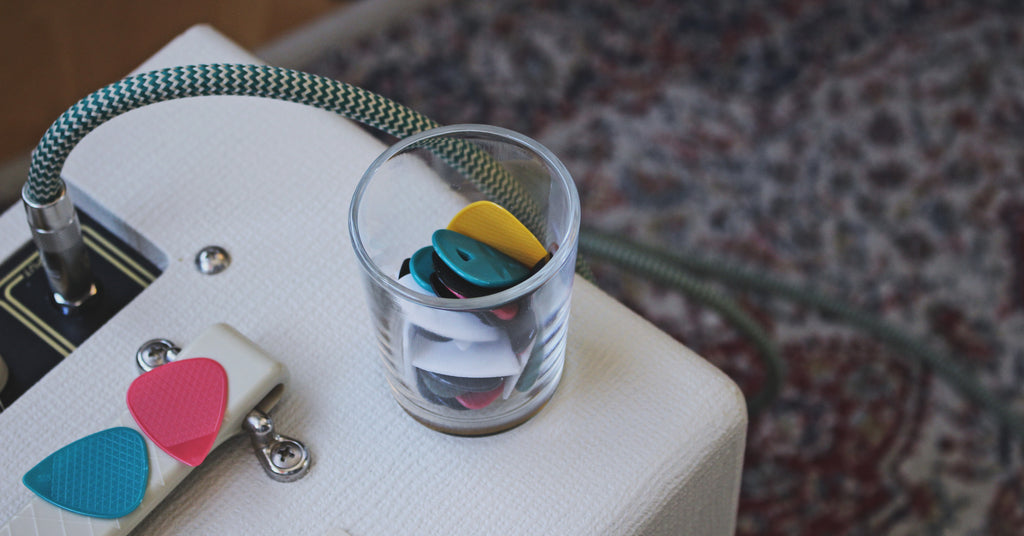
From time to time, there will be another guitar player who will need to borrow a guitar pick, especially during a tour, or live performance.
Sometimes the borrowed picks find their way back. However, often they walk off with the player and you never see them again.

Start thinking of picks as having the value they deserve and treat them that way. Do not hesitate to ask for your pick to be returned.
Like the container, this is an accessory that allows you to keep your guitar picks where they belong, in a known place.
In addition, in a live performance, a guitar pick holder can be used to store your picks during the songs that require fingerpicking, that do not require a pick.
It is the perfect guitar accessory for the live player who needs quick access to guitar picks anywhere and everywhere on the stage.
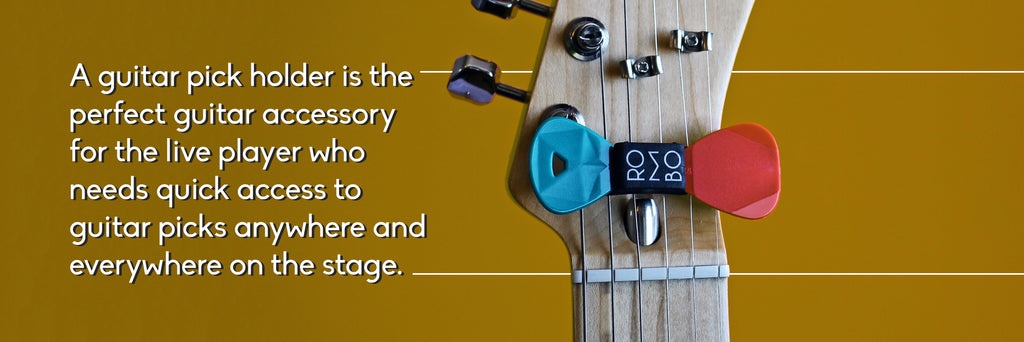
There are holders for the guitar neck and for the microphone stand. Some people create their own DIY holders with double-sided tape. This can work for a while, but has some disadvantages: The tape can lose it’s capacity to hold the pick over time, and the glue can damage the guitar surface.
If you are looking for an adhesive-free guitar pick holder click HERE.
As simple as it sounds. If you have played many years, you are probably storing your guitar picks in your pockets. This is the most common way to lose your guitar picks.
A day after playing guitar, you will use different jeans, with no guitar picks in your pockets...or even worse, you will do laundry with the picks inside your jeans, and your washing machine will eat them!
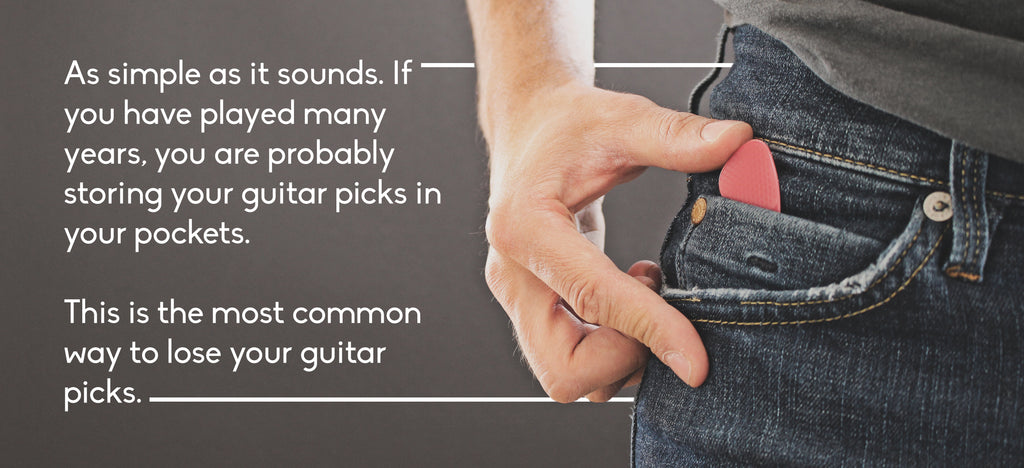
If you are very careful, you won’t need the following advice. But just in case this happens, we have some suggestions for you.

With this small checklist, you can easily find your guitar pick in a systematic way. But, what happens if this does not work?
If the guitar pick gets lost you can only do one thing: Hope you have some extra guitar picks!
It is important to have some additional unused guitar picks in a secure place. Before that, you have to decide which guitar picks types are essential for you, and at least have a pair of them for this emergency.
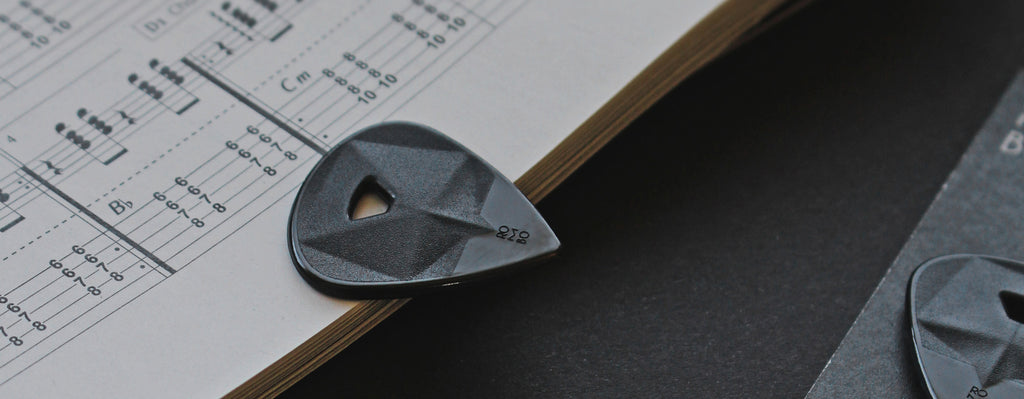
We have a guide to choosing the right guitar pick, which you can find HERE.
It can be very annoying to find out you cannot continue playing, because your guitar pick is gone, and having extra picks will save time, which you can use to practice guitar.
Do you know somebody who is always losing their guitar picks?
Please share this advice with them!
In case you are trying to learn the guitar, the first thing you need to know is how to hold a guitar pick the right way.
Guitar pick or plectrum is a small object that you hold in your hands and play the guitar strings. The quality of guitar you are playing depends mainly on the way you are holding its pick.
So, before you officially start learning guitar, you should learn to hold the plectrum in the right manner.

Mentioned below in this article are some of the tips and tricks which you can use for holding the guitar pick in your hand so that it doesn’t feel awkward and helps you in playing the guitar in the most suitable way.
The first and the easiest manner of holding a guitar plectrum is that you keep it in between your index finger and your thumb. Hold it in a way that it fits tightly in between your fingers. Now keep the position of your in such a manner that it can easily brush all the strings of your guitar.

As while playing, you will have to move the plectrum all over the strings and in order to be able to play guitar perfectly, the plectrum needs to touch all of the strings easily.
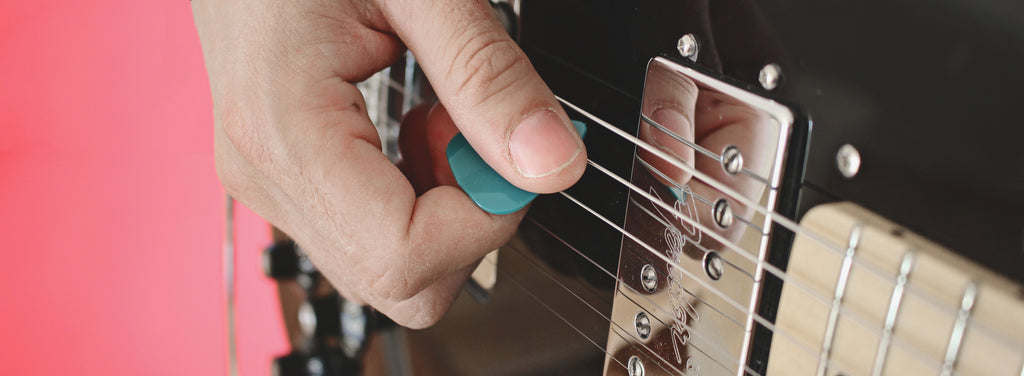
One thing that you need to keep in mind is that there are a lot of different types of plectrums available in the market and you should choose the one that works best for you. Once you have chosen the perfect pick, try to practice with it as much as possible.
We created a four-step guide to choosing your guitar pick, which you can find here:
https://rombopicks.com/blogs/insight-rombo/how-to-choose-the-right-guitar-pick
Brush it against the strings of your guitar so that your hands move easily and it produces a sound.
Another technique that you can use to hold a guitar pick in your hand is that you keep it in your dominant hand. This is the hand that you use the most, so it will be easier for you to keep the plectrum in it and play the guitar.
Some people prefer to play the guitar chords with the hand that they don’t use more often i.e non-dominant. So by holding the plectrum in your dominant hand and controlling the chords with no dominant one, you can easily brush the guitar strings and produce music.

Now place your one hand on the neck of the guitar and hold the plectrum between your index finger and thumb of the dominant hand. Keep in mind that the strings of your guitar are facing away from you. Keep the guitar on your knees, as for a beginner, it is easier to play the guitar while sitting. But in case you want to play standing up, you can use a shoulder strap so that it is easier for you to control.
Keep your hand steady but flexible. Steady because you need to hold the guitar plectrum and flexible because you need to keep brushing it over all of the strings.

A good sound will only be produced if you are moving your hands the right way. Keeping them too rigid will result in an unpleasant sound which no one likes to listen to. But once again, keep in mind that a good sound can only be produced after practice.
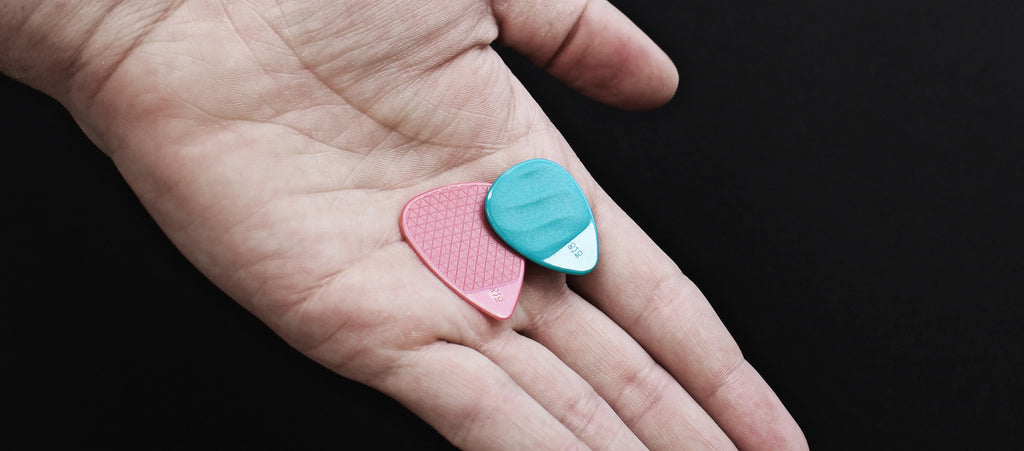
During the initial times, you only need to focus on getting your hands used to the guitar. So that it knows where the strings are, which chords to play and where to keep the plectrums. These are the basic skills that everyone needs to learn before officially starting out various tunes on the guitar.
For those more advanced guitarists looking to improve their guitar playing speed, click HERE.
Once you are in your comfortable position, rest your hand holding the plectrum on the strings of the guitar. Keep in mind that your hand should cover at least half of the plectrum. Some of the picks are made in a way that they are folded from one side to easily fit your index finger and your thumb on it.

Here you can find an example: Rombo Origami
Keep the grip of your hand as firm as possible but make sure it is easily movable so that once you start playing, you can brush the strings without making any extra effort. Never loosen your grip on the plectrum because it might fall off your hand while playing.
Now if you are a beginner, it is good that you are trying to get as much help as possible because this will help you in becoming a good guitarist within a minimum amount of time. By now, you do know how to carefully hold a plectrum (i.e between your index finger and thumb) now rest it over the strings.
Keep in mind that it should just lightly brush them so that only placing it there doesn’t produce any sound. The sound of your guitar must only be produced once you are moving the plectrum all over the strings.

One side of the strings is thin while the other one is thicker, practice on your guitar by gently moving your hand from the thicker side of the string to the thinner one. Although during the initial stages, rhythms produced would be rough but don’t worry about it. As you are only learning to hold the plectrum in the right way. There is a lot of time for learning guitar but prior to that, practicing is the most important thing that you need to do.
As this is the starting phase, try to practice as much as possible. As practicing will not only make your hand steady but it will also help you in maintaining your physical strength. The more your practice, the better you will be at playing guitar.
All successful guitarists need to play for hours in front of their audience and a person is only able to do that if he has done enough practicing.

So, in case you are taking more time trying to hold the guitar plectrum in the right way, tune the string or adjust the strap, don't worry about it. As all the great guitar players have started from this exact step so just polish your skills and you too will be an amazing guitarist really soon.
Note: There are many annoying things in life, but there’s nothing more annoying than losing a guitar pick you just had in your hand, and then realize that it has disappeared forever! - 4 Tips To Not Lose Your Guitar Picks
If your hands do an arduous job, then you must give them the right tools, right?
The material with which it is made can influence the definition of tone, attack, and flexibility. Therefore, without paying attention to it, you could hardly find your personal sound.
Are you curious about the materials used for the Rombo guitar picks?
Read a full article about it here:
https://rombopicks.com/blogs/insight-rombo/guitar-pick-materials-at-rombo
Judith Heindorf & Carlos Diez Macia GbR
Auf der Steige 29
71686 Remseck am Neckar
DEUTSCHLAND
Melde dich zu unserem Newsletter an und erhalte alle Neuigkeiten zu Sales, Neuerscheinungen und vielem mehr…
Mit der Anmeldung stimmst du unseren Datenschutzbedingungen zu.
© 2025 ROMBO.
ist eine registrierte EU-Marke.
Wir nutzen Shopify.